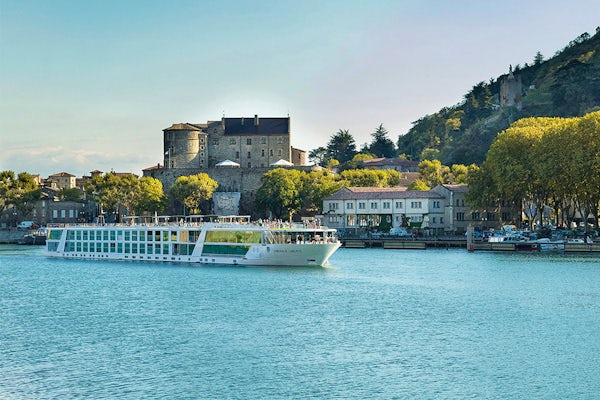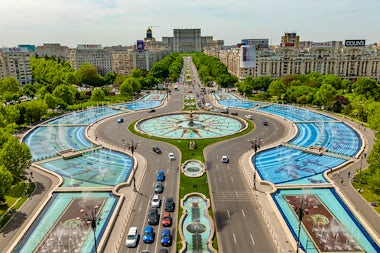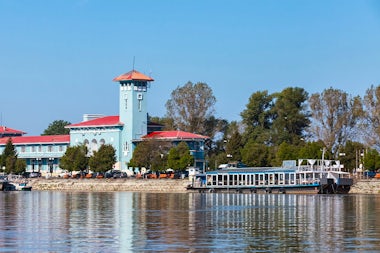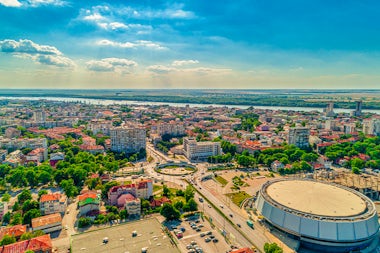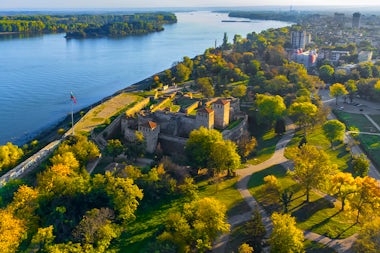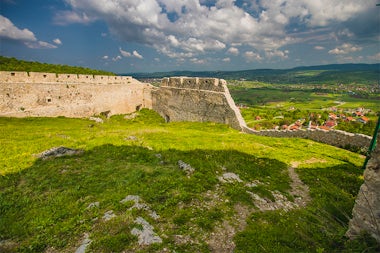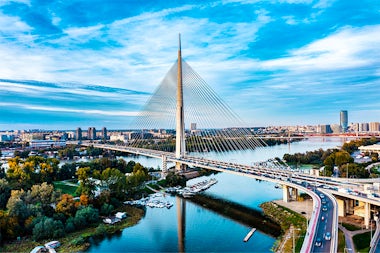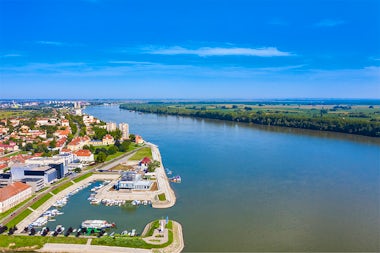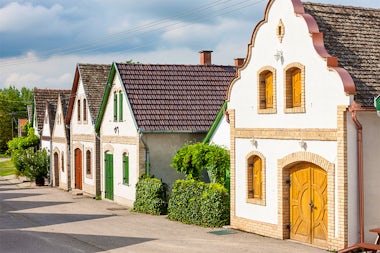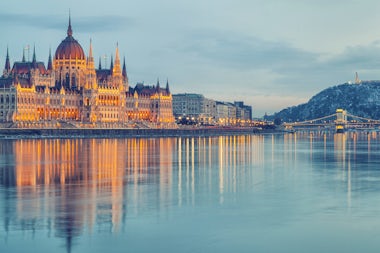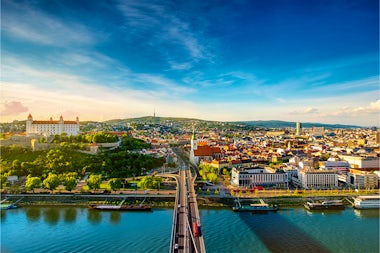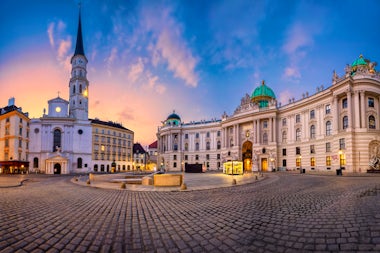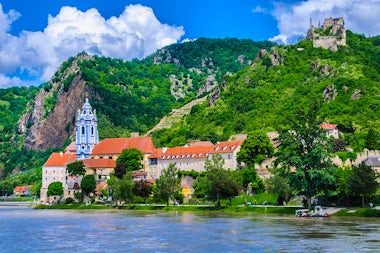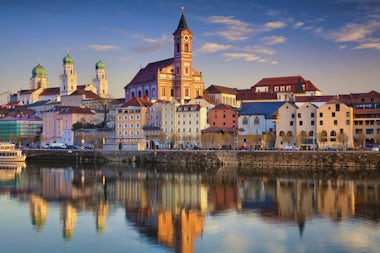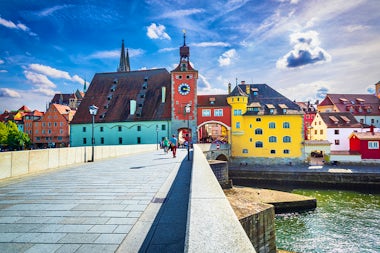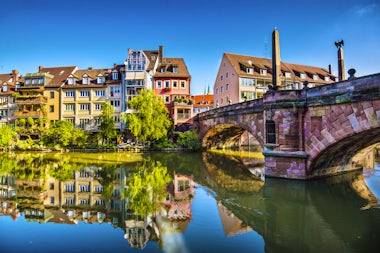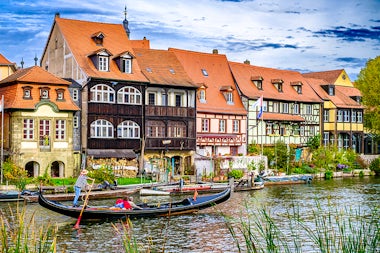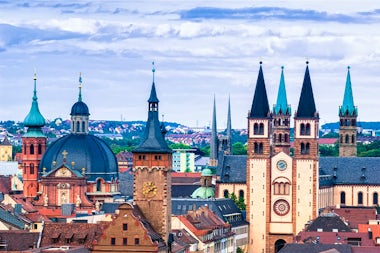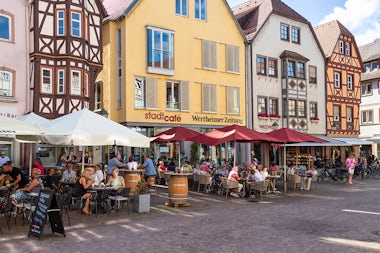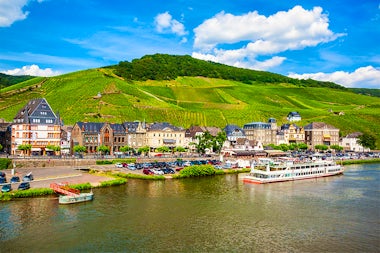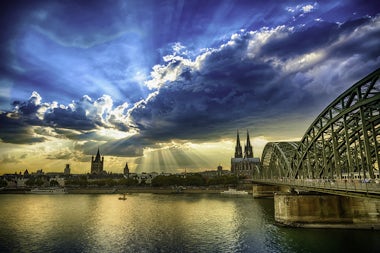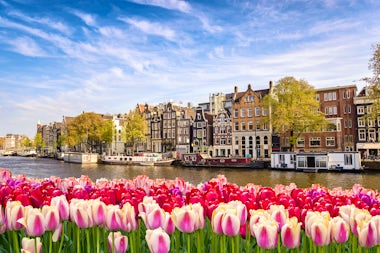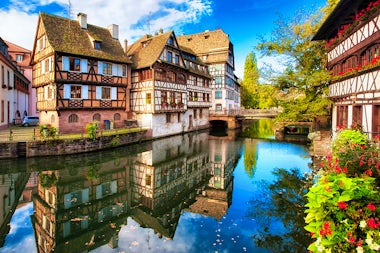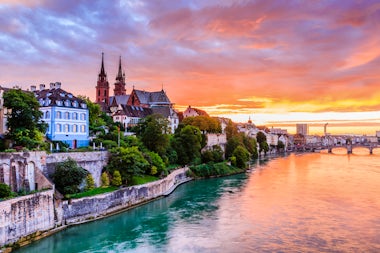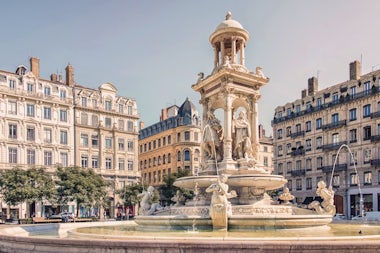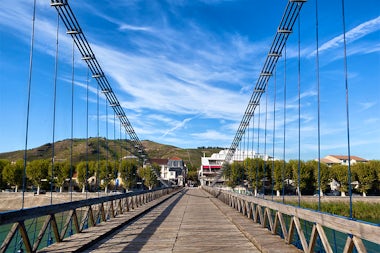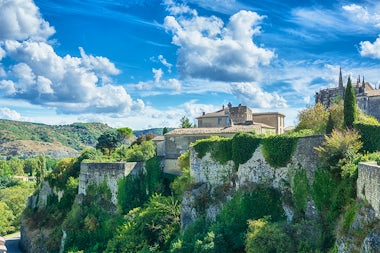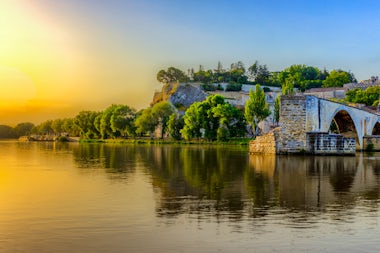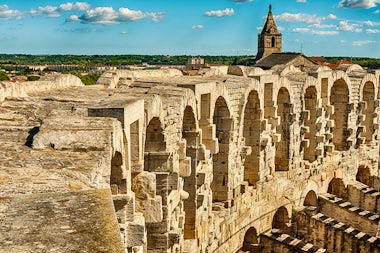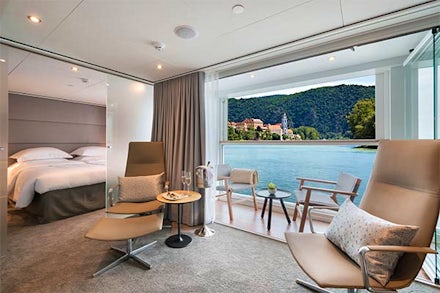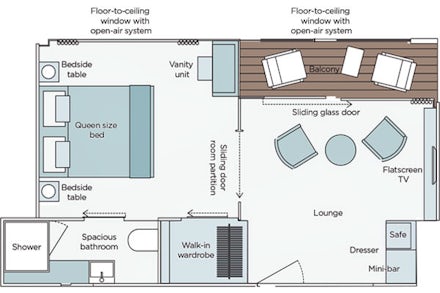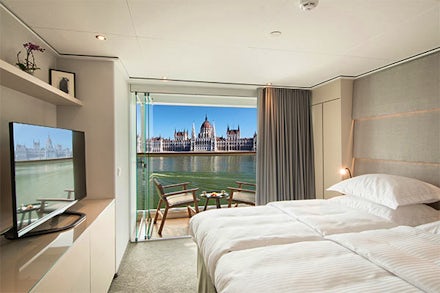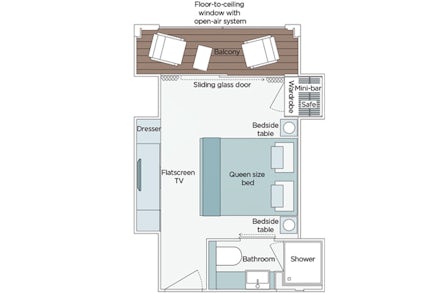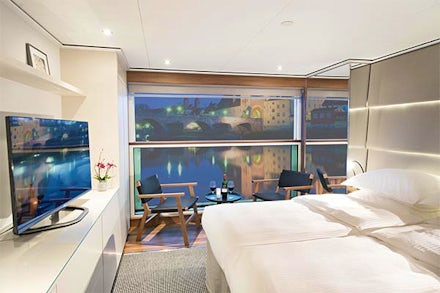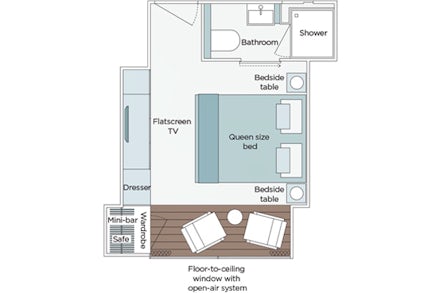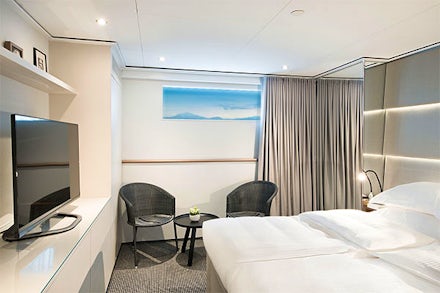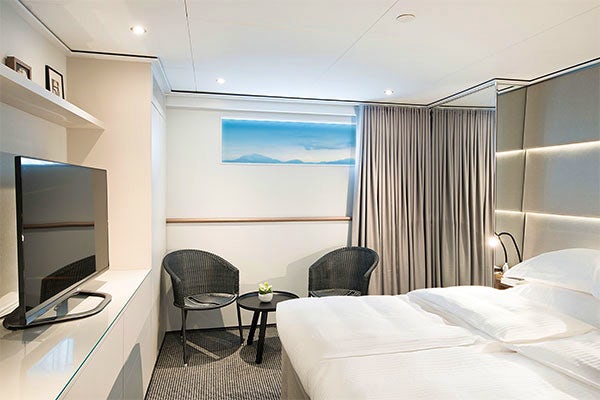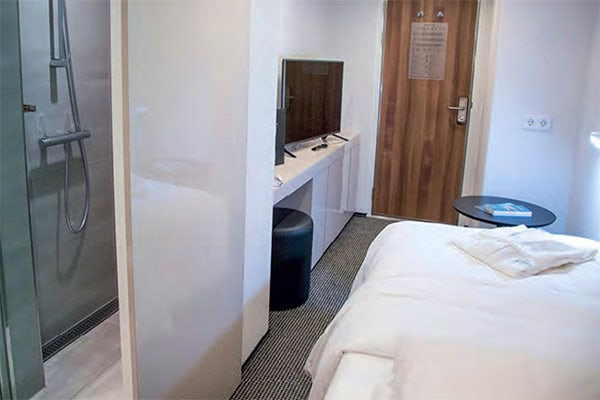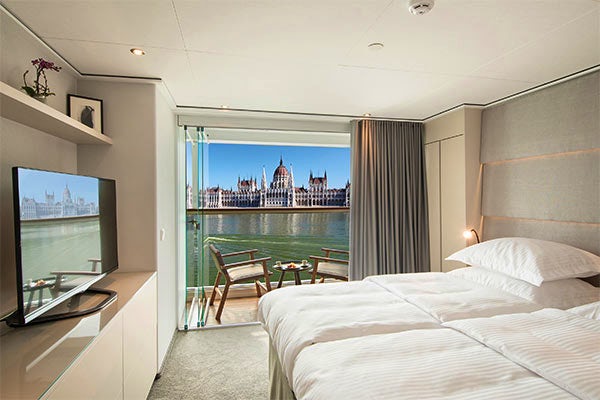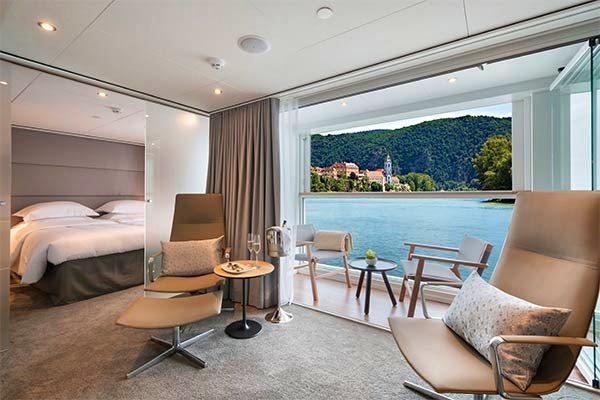| 1 |
Friday, April 24, 2026 |
Bucharest, Romania |
Embark |
4:00 PM |

Bucharest, located on the banks of the Dambovita River, is the capital city of Romania and its largest city. The city boasts wide, tree-lined boulevards and a range of architectural styles including Historical, Art Deco, as well as on-going Modern. Finding a 300 year old church, a steel-and-glass office building and Communist-era high rise apartment blocks next to one another is a common sight. Read more about Bucharest, Romania
|
| 2 |
Saturday, April 25, 2026 |
Giurgiu, Romania |
8:00 AM |
4:00 PM |

Giurgiu, 65 km south of Bucharest, is the capital city of Giurgiu County, Romania. It is situated amid mud-flats and marshes on the left bank of the Danube facing the Bulgarian city of Rousse on the opposite bank. Three small islands face the city, and a larger one shelters its port, Smarda. Read more about Giurgiu, Romania
|
| 3 |
Sunday, April 26, 2026 |
Rousse, Bulgaria |
8:00 AM |
4:00 PM |

Rousse - aka Ruse, Russe - in NE Bulgaria lies on the right bank of the Danube River, opposite the Romanian city of Giurgiu. An important cultural, commercial and industrial centre, it is often called Little Vienna as it has become the most important Bulgarian river port. With more than 290 monuments and its preserved buildings from the end of 19th and the beginning of 20th centuries, it is also ‘easy visiting’ as most of the sights, such as the old city that constitutes the square around the city’s Historical Museum, are located in the centre of the city. Read more about Rousse, Bulgaria
|
| 4 |
Monday, April 27, 2026 |
Vidin, Bulgaria |
8:00 AM |
4:00 PM |

Vidin is a port town on the southern bank of the Danube River in NW Bulgaria. Renowned for its availability of mineral water, it is also one of the oldest towns along the Bulgarian Danube Bank, and is a starting point for excursions along the Danube. An agricultural and trade centre, Vidin has a fertile hinterland renowned for its wines. Read more about Vidin, Bulgaria
|
| 5 |
Tuesday, April 28, 2026 |
Golubac, Serbia |
8:00 AM |
4:00 PM |

Golubac is a scenic town located in eastern Serbia. It is renowned for its mediaeval fortress and stunning location along the Danube River. The Golubac Fortress, with its dramatic towers and walls, stands at the entrance to the Iron Gates gorge, offering breathtaking views of the river and surrounding cliffs. Read more about Golubac, Serbia
|
| 6 |
Wednesday, April 29, 2026 |
Belgrade, Serbia |
8:00 AM |
4:00 PM |

Belgrade is the capital and largest city of Serbia, lying on two international waterways at the junction of the Sava and Danube rivers. Here is found the statue of Pobednik (Winner), one of the symbols of Belgrade. It is also the second largest city on the Danube River and is one of the oldest cities in Europe. Read more about Belgrade, Serbia
|
| 7 |
Thursday, April 30, 2026 |
Vukovar, Croatia |
8:00 AM |
4:00 PM |

Vukovar is a city and municipality in eastern Croatia. Located at the junction of the Vuka River and the Danube, it is the largest Croatian town and river port. It is famous for the heroic battle in the Patriotic war and the unprecedented devastation it caused. Read more about Vukovar, Croatia
|
| 8 |
Friday, May 1, 2026 |
Kalocsa, Hungary |
8:00 AM |
4:00 PM |

Kalocsa is a town in Bacs-Kiskun county, Hungary, approximately 120 km south of Budapest. It is one of the oldest towns in Hungary with several buildings from the 18th Century. Amongst its historical buildings are a fine cathedral, and the archiepiscopal palace - both from the 18th C - as well as an astronomical observatory, a seminary and colleges, all of which attract visitors. Read more about Kalocsa, Hungary
|
| 9 |
Saturday, May 2, 2026 |
Budapest, Hungary |
8:00 AM |
Overnight |

Budapest is the capital and largest city of Hungary, situated on both banks of the river Danube, with its 346 river cruise ships (2019). Originally with the cities of Buda on the west bank and Pest on the east bank, it became a single city with their unification in 1873. The city’s rich and colourful history, its extensive World Heritage Site including the Danube River banks, the Buda Castle Quarter, Andrássy Avenue, and the Millennium Underground Railway, have resulted in its becoming an important tourist centre in Central Europe. Read more about Budapest, Hungary
|
| 10 |
Sunday, May 3, 2026 |
Budapest, Hungary |
|
4:00 PM |

Budapest is the capital and largest city of Hungary, situated on both banks of the river Danube, with its 346 river cruise ships (2019). Originally with the cities of Buda on the west bank and Pest on the east bank, it became a single city with their unification in 1873. The city’s rich and colourful history, its extensive World Heritage Site including the Danube River banks, the Buda Castle Quarter, Andrássy Avenue, and the Millennium Underground Railway, have resulted in its becoming an important tourist centre in Central Europe. Read more about Budapest, Hungary
|
| 11 |
Monday, May 4, 2026 |
Bratislava, Slovakia |
8:00 AM |
4:00 PM |

Bratislava, the capital of Slovakia, is situated on both banks of the Danube River between Austria and Hungary, and is the only national capital that borders two independent countries. Bratislava and Vienna are also two of Europe's closest national capitals, less than 60 km apart. The cityscape of Bratislava is noted for its medieval towers and grandiose 20th century buildings, but has undergone profound changes in a construction boom at the start of the 21st century. Read more about Bratislava, Slovakia
|
| 12 |
Tuesday, May 5, 2026 |
Vienna, Austria |
8:00 AM |
4:00 PM |

Vienna, Austria's capital city, has a population of around two million and is located to the east of the Alps in the Vienna Basin. Architectural styles range from classic to modern, and include some of the world’s best known examples of Art Nouveau. Fascinating features are the few high-rise buildings, and numerous parks and gardens, with many statues of famous people such as Mozart and Strauss. Read more about Vienna, Austria
|
| 13 |
Wednesday, May 6, 2026 |
Durnstein, Austria |
8:00 AM |
4:00 PM |

Durnstein, a hamlet and much visited tourist destination, lies nestled within Austria’s vineyard-rich Wachau Valley 80 km west of Vienna. Crowned by the ruins of a castle fortress, the cobblestone streets, the baroque monastery, the 15th century Parish Church (with one of the finest Baroque towers in Austria), the old burgher and townhouses dating back from the 16th and 18th C, and visitors feel they are strolling through history. Wander along the banks of the Danube where small shops invite you to buy, with virtually every shop offering free samples of brandy, liqueur, or schnapps. Read more about Durnstein, Austria
|
| 14 |
Thursday, May 7, 2026 |
Passau, Germany |
8:00 AM |
4:00 PM |

Passau is a town in Lower Bavaria, Germany, at the junction of three Rivers: the Danube, the Inn from the South, and the Ilz coming out of the Bavarian Forest to the North. During the Renaissance and early modern period it became one of the most prolific centres of sword and bladed weapon manufacture in Germany. Today it is notable for its gothic and baroque architecture. Read more about Passau, Germany
|
| 15 |
Friday, May 8, 2026 |
Regensburg, Germany |
8:00 AM |
4:00 PM |

Regensburg is a city in Bavaria, Germany, situated at the junction of the Danube and Regen rivers. The large medieval centre of the city is a UNESCO World Heritage Site. Home to two thousand years of living history with some of Europe's most important architectural and cultural monuments, plus fascinating museums and art collections, make this an attractive place to spend some time. Read more about Regensburg, Germany
|
| 16 |
Saturday, May 9, 2026 |
Nuremberg, Germany |
8:00 AM |
4:00 PM |

Nuremberg, is a city in the German state of Bavaria, situated on the Pegnitz River and the Rhine-Main-Danube Canal. In the Middle Ages the city expanded and increased in importance due to its location on a key trade route from Italy to Northern Europe. Nuremberg held great significance during the Nazi Germany era, as the site of huge Nazi Party conventions, and an important site for military production, including airplanes, submarines and tanks. Read more about Nuremberg, Germany
|
| 17 |
Sunday, May 10, 2026 |
Bamberg, Germany |
8:00 AM |
4:00 PM |

Bamberg is a town in Bavaria, Germany, located in Upper Franconia at the junction of the Regnitz and Main rivers. It is a disarmingly beautiful architectural masterpiece with an almost complete absence of modern eyesores. The town extends over seven hills, each crowned by a beautiful church, which has led to Bamberg being called the ‘Franconian Rome’. Read more about Bamberg, Germany
|
| 18 |
Monday, May 11, 2026 |
Wurzburg, Germany |
8:00 AM |
4:00 PM |

Wurzburg, aka Wuerzburg, is a city on the Main River at the northern tip of Bavaria, Germany. It is rich in history with evidence of a Celtic fortification having been built there back in 1000 BC. The city was severely bombed during WWll and the city centre, dating back to medieval times, was totally destroyed. Read more about Wurzburg, Germany
|
| 19 |
Tuesday, May 12, 2026 |
Wertheim, Germany |
8:00 AM |
4:00 PM |

Wertheim is a town at the junction of the rivers Tauber and Main in SW Germany. It is one of the most beautiful city centres in Germany, with its numerous half-timbered houses - one more beautiful than the other - and which you can't take your eyes off. Some of them go back to the 16th century. Read more about Wertheim, Germany
|
| 20 |
Wednesday, May 13, 2026 |
Koblenz, Germany |
8:00 AM |
4:00 PM |

Koblenz (aka Coblenz, Coblence) is one of the largest cities on the Rhine River in Germany and is situated on both banks of the Rhine at its junction with the Moselle. In 55 BC Roman troops commanded by Julius Caesar reached the Rhine, and the remains of a large bridge built by them in 49 AD are still visible. That the historical pattern of French occupation over the centuries has now completely ended, is encapsulated in the imposing William1st Monument that is a nationalistic declaration of the German refusal of any French claims to the area, and to German unity. Read more about Koblenz, Germany
|
| 21 |
Thursday, May 14, 2026 |
Cologne, Germany |
8:00 AM |
4:00 PM |

Cologne, situated on the River Rhine and Germany’s fourth largest city, was recognised by the Romans as a major centre for their trade routes. Subsequently, considerable Roman remains can be found in contemporary Cologne, especially near the wharf area, where a notable discovery of a 1900 year old Roman boat was made in late 2007. Due to WWII air raids, today Cologne is notable for its simple and modest post-war buildings, but fortunately is still home to a few interspersed pre-war buildings that were reconstructed due to their historical importance. Read more about Cologne, Germany
|
| 22 |
Friday, May 15, 2026 |
Amsterdam, Netherlands |
8:00 AM |
Overnight |

Originally a dam in the river Amstel, Amsterdam today is the capital and largest city of the Netherlands, as engineered dams, sea gates, and the 19-mile dyke walling out the Zuider Zee prevent this low-lying country from being reclaimed by the North Sea. Interestingly, the 17th century canals of Amsterdam located in the heart of the city have been added to the UNESCO World Heritage List. The main tourist attractions are undoubtedly the famous Museums such as the Rijksmuseum, the Van Gogh Museum, and the Stedelijk Museum. Read more about Amsterdam, Netherlands
|
| 23 |
Saturday, May 16, 2026 |
Amsterdam, Netherlands |
8:00 AM |
4:00 PM |

Originally a dam in the river Amstel, Amsterdam today is the capital and largest city of the Netherlands, as engineered dams, sea gates, and the 19-mile dyke walling out the Zuider Zee prevent this low-lying country from being reclaimed by the North Sea. Interestingly, the 17th century canals of Amsterdam located in the heart of the city have been added to the UNESCO World Heritage List. The main tourist attractions are undoubtedly the famous Museums such as the Rijksmuseum, the Van Gogh Museum, and the Stedelijk Museum. Read more about Amsterdam, Netherlands
|
| 24 |
Sunday, May 17, 2026 |
Amsterdam, Netherlands |
|
4:00 PM |

Originally a dam in the river Amstel, Amsterdam today is the capital and largest city of the Netherlands, as engineered dams, sea gates, and the 19-mile dyke walling out the Zuider Zee prevent this low-lying country from being reclaimed by the North Sea. Interestingly, the 17th century canals of Amsterdam located in the heart of the city have been added to the UNESCO World Heritage List. The main tourist attractions are undoubtedly the famous Museums such as the Rijksmuseum, the Van Gogh Museum, and the Stedelijk Museum. Read more about Amsterdam, Netherlands
|
| 25 |
Monday, May 18, 2026 |
Cologne, Germany |
8:00 AM |
4:00 PM |

Cologne, situated on the River Rhine and Germany’s fourth largest city, was recognised by the Romans as a major centre for their trade routes. Subsequently, considerable Roman remains can be found in contemporary Cologne, especially near the wharf area, where a notable discovery of a 1900 year old Roman boat was made in late 2007. Due to WWII air raids, today Cologne is notable for its simple and modest post-war buildings, but fortunately is still home to a few interspersed pre-war buildings that were reconstructed due to their historical importance. Read more about Cologne, Germany
|
| 26 |
Tuesday, May 19, 2026 |
Koblenz, Germany |
8:00 AM |
4:00 PM |

Koblenz (aka Coblenz, Coblence) is one of the largest cities on the Rhine River in Germany and is situated on both banks of the Rhine at its junction with the Moselle. In 55 BC Roman troops commanded by Julius Caesar reached the Rhine, and the remains of a large bridge built by them in 49 AD are still visible. That the historical pattern of French occupation over the centuries has now completely ended, is encapsulated in the imposing William1st Monument that is a nationalistic declaration of the German refusal of any French claims to the area, and to German unity. Read more about Koblenz, Germany
|
| 27 |
Wednesday, May 20, 2026 |
Mannheim, Germany |
8:00 AM |
4:00 PM |

Mannheim, in SW Germany, lies at the confluence of the Rhine and Neckar Rivers. Its nick-name ‘City of the Squares’ is due to the fact that, unlike other German cities, its central area is set out in a grid pattern just like most North American and Australian cities. Of interest is the Water Tower, just east of the city’s centre, the civic symbol of this city. Read more about Mannheim, Germany
|
| 28 |
Thursday, May 21, 2026 |
Strasbourg, France |
8:00 AM |
4:00 PM |

Strasbourg, France’s great north-eastern metropolis and the intellectual and cultural capital of Alsace, is the ultimate European city. It has flavours of both France and Germany, and sits astride the border of the two countries. Today the residents have mixed feelings about their ‘Frenchness’ or ‘Germanness’, with many agreeing they are not either French or German, but a bit of both. Read more about Strasbourg, France
|
| 29 |
Friday, May 22, 2026 |
Breisach, Germany |
8:00 AM |
4:00 PM |

The German town of Breisach is situated along the Rhine River on the French and German border, about halfway between Freiburg and Colma. During WWII 85% of Breisach was destroyed and the early 13th century cathedral of St Stephansmünster was heavily damaged. Fortunately it is a great place to visit as it has since been restored with many of its remarkable features still intact. Read more about Breisach, Germany
|
| 30 |
Saturday, May 23, 2026 |
Basel, Switzerland |
8:00 AM |
4:00 PM |

Basel on the river Rhine is Switzerland's third most populous city, and located where the Swiss, French and German borders meet. Indeed, the river cruise ships berth within a stone’s throw of the triple intersection. It has suburbs in France and Germany, and interestingly the language spoken is called Basel German. Read more about Basel, Switzerland
|
| 31 |
Sunday, May 24, 2026 |
Lyon, France |
8:00 AM |
4:00 PM |

Lyon (or Lyons) is the capital of the Rhône-Alpes region in eastern France, located at the junction of the Rhône and the Saône Rivers, between Paris and Marseille. The city is known for its historical architectural landmarks at the Historic site, so that UNESCO recently listed Vieux Lyon, including the Croix-Rousse and Presqu'île areas, as a world heritage site. This is well deserved as the Gothic and Renaissance district is famous for its maze of narrow streets with quaint cathedrals, churches and buildings of historical importance that feature architecture from the 12th century to modern times. Read more about Lyon, France
|
| 32 |
Monday, May 25, 2026 |
Macon, France |
8:00 AM |
4:00 PM |

Mâcon, during WWII a major centre for the French Resistance, is a town in the Burgundy region in eastern France, located on the west bank of the Saône River. With buildings painted burnt sienna, buttermilk and rose, Mâcon has a distinctly Mediterranean atmosphere. To get a feel of this town, head for the terrace of the café in the Maison de Bois, a house covered in elaborate wooden carvings normally reserved for interiors. Read more about Macon, France
|
| 33 |
Tuesday, May 26, 2026 |
Tournon, France |
8:00 AM |
4:00 PM |

Tournon - aka Tournon-sur-Rhône - is a town in the Rhône-Alpes region of SE France, located on the west bank of the Rhône River, 85 km south of Lyon. Tournon's main attraction is a feudal castle overlooking the town and the river. The castle, with foundations dating back to the 10th C, has a section built in the Renaissance period that today houses the town museum. Read more about Tournon, France
|
| 34 |
Wednesday, May 27, 2026 |
Viviers, France |
8:00 AM |
4:00 PM |

The small walled city of Viviers is a town in the mountainous Rhône-Alpes region in SE France, and is located on the west bank of the Rhône River, 80 km north of Arles. Due to its sheltered location, the city has been able to keep its old world charm to this day, with important Roman remains as well as Medieval and Renaissance buildings. Indeed, the Gallo-Roman bridge, built between the 2nd and the 3rd century on the right bank of the Rhône, spans eleven arches, while the ancient city Alba la Romaine from the 1st Century is today an archaeological site covering 30 hectares of Gallic-Roman ruins and famous vineyards. Read more about Viviers, France
|
| 35 |
Thursday, May 28, 2026 |
Avignon, France |
8:00 AM |
4:00 PM |

Avignon is a town in the Provence-Alpes-Côte d'Azur region in SE France, located on the Rhône River just north of its junction with the Durance River. Strategically situated high above the Rhône and encircled by medieval ramparts, Avignon's walled old town is a warren of cobbled streets, lantern-lit passageways and architectural treasures. Bathed in the extraordinarily brilliant Provencal light, this former papal enclave has long attracted artists and painters as well as those in search of a cultural change. Read more about Avignon, France
|
| 36 |
Friday, May 29, 2026 |
Arles, France |
8:00 AM |
4:00 PM |

The Rhône forks into two branches just upstream of Arles, forming the Camargue delta. It is the largest commune in Metropolitan France in terms of territory, and has more than seven times the area of Paris. Established by the Greeks in 600 BC, Arles was developed by the Romans who built a canal joining Arles to the Mediterranean Sea. Read more about Arles, France
|
| 37 |
Saturday, May 30, 2026 |
Arles, France |
8:00 AM |
Disembark |

The Rhône forks into two branches just upstream of Arles, forming the Camargue delta. It is the largest commune in Metropolitan France in terms of territory, and has more than seven times the area of Paris. Established by the Greeks in 600 BC, Arles was developed by the Romans who built a canal joining Arles to the Mediterranean Sea. Read more about Arles, France
|
